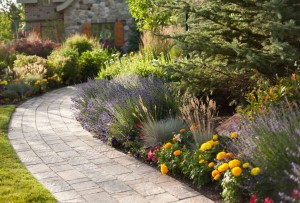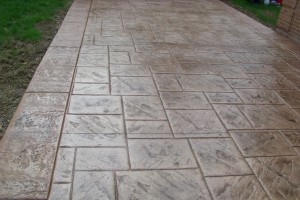Some paving materials are more cost-effective than others, and certain types are more durable and easier to maintain.The most commonly used paving materials today are concrete slabs and paving stones. Each option can provide different advantages depending on your needs.
Poured concrete slabs are often used for outdoor residential spaces due to their cost and relative ease of installation. With the development of stamped concrete, homeowners also have options as far as designs and textures are concerned. Paving stones are individual sections made from various materials like natural stone, concrete or brick. Many of these pieces interlock, which makes for a flexible system that is extremely durable. Standard concrete slabs are generally lower in cost per square foot than the alternative. Typically, you will pay 10%-15% more if you choose paving stones over standard concrete slabs. If you decide to upgrade to stamped concrete, paving stones will most likely cost you the same or even less in most cases. While a concrete slab is more affordable upfront, the long-term costs for repairs and/or replacements will almost always outweigh the initial savings.
Maintenance
Concrete is relatively easy to maintain, however, staining and cracking will often occur and become an eye-soar as the slab ages.If you upgrade to stamped concrete, the cracks and stains can often be hidden or become less noticeable. You can also coat each slab with a protective sealant, to help prevent stains from penetrating the surface. If the cracks and staining become more noticeable you will most likely need to replace the entire slab.You can opt to spot treat problem areas, however, the treated areas will often end up looking like a patch or band-aide, since it is very hard to match the color of an existing concrete slab. Most paving stones generally require little care, but the joints between each stone may need attention from time to time. Although the base of each stone is designed to flex with any ground movement, the stones can still shift or crack over time .If any settling should occur, the stones can be lifted, the base can be re-compacted, a new layer of bedding sand can be applied and then the stones can be set back into place.
Durability
Concrete slabs longevity is greatly affected by the movement of the earth. Slabs are prone to splitting and cracking if the ground beneath it shifts.The surface of the concrete slab may remain level for awhile, but a crack is inevitable once the soil becomes unstable. Additionally, changes in temperature can cause the concrete to expand and contract, which will also result in cracking.With pavers, water rarely tends to settle onto the surface because of the numerous joints in between each piece. With a properly graded installation, drainage issues should never occur. Pavers are rated to be 4 times as strong as a typical concrete slab which means they can handle 4 times as much weight on their surface before they would crack. A great benefit about pavers is that we are a Authorized Contractor through Belgard, which means Belgard backs up their paving stone products with a Lifetime Guarantee against breaking and cracking, so if a paver should ever fail, you will be covered. Due to the installation process and their interlocking system, paving stones are extremely flexible and are able to disperse the pressure or weight evenly, which prevents cracking. Some paving materials are stronger than others, but most individual units are less susceptible to breakage because they are made to move with the earth. Paving bricks also stand up very well to changes in the weather conditions with their ability to expand and contract without cracking.
Replacement and Repairs
If a concrete slab becomes severely damaged, chances are it will need to be replaced. The entire slab must to be removed, and you will need to have new concrete poured.This can be costly if more than one area needs replacing. You can fix minor problems by patching cracks or having a professional resurface the concrete. Patching often results in mismatched coloring, which can be unsightly in prominent areas. Because pavers consist of individual interlocking stones, each unit can be replaced as needed. When one paver becomes damaged the interlocking system allows you to easily remove only that piece and replace it with a new one. This is a lot less expensive option than replacing an entire slab of concrete. Another advantage is that if you should ever need to get access to underground utilities or fix a leaking drain-line, you can do so relatively easily. The stones can be removed, the problem area can then be addressed and then the pavers can be replaced without even knowing there was a problem.With a concrete slab, you would have to saw cut, remove the concrete, address the problem area and then re-pour new concrete, which will never look the same as the existing slab. Now you will be left with a patch. Typical paver maintenance may include power washing your pavers and resealing the joints every couple of years.
Paver walkway Stamped concrete

